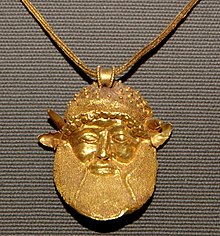Acheloos (mythology)

Acheloos ( ancient Greek Ἀχελῷος Achelṓos ), also Achelous and Achilaos , is the personification of the river Acheloos in Greek mythology .
Acheloos is considered to be the oldest and also the most distinguished of the Greek river gods . He is the son of Oceanus and Tethys . He is able to change his shape (an allusion to the river whose deity he was and which also changed its course again and again). As the river god, he is responsible for the abundance of fresh water and the fertility of the land. Acheloos is the father of the sirens , the nymph Kallirrhoë , who was married to Alkmaion , and the nymph Kastalia , who was the spring nymph of the important Delphic spring.
When Acheloos fell in love with Deianeira , daughter of Oineus , he came into conflict with his adversary Heracles . Acheloos turned first into a snake; at last into a bull, which did not help him: Heracles broke off one of the horns in his bull shape. In order to get his horn back, he had to exchange a horn from the goat Amaltheia , which Zeus had suckled (later called the cornucopia ). Since the 1st century BC The episode with the horn was also reinterpreted as the Heraklesian correction of the Arcarnanian river.
Acheloos was worshiped not only regionally, but throughout Greece. His name could even be used synonymously for "water". His cult is mentioned several times in inscriptions. The most important place of worship was the oracle of Dodona . During the 4th century BC However, his cultic veneration declined sharply.
In the ancient art Acheloos is a frequently encountered motif. In literature he remained popular as an example of the unfortunate lover until the Roman Empire . In the fine arts he was sometimes depicted as a man with a horn, but mostly as a bull with a human face and a long, damp beard. Individual representations of the god predominated. Depictions of the fight with Heracles were rather rare. Often only the face was shown, and in many cases only as a mask. Acheloos also appears as the father of the nymphs on the Attic nymph reliefs. Especially in Greater Greece and Sicily , it was also the motif of numerous coinage. The representation of Achelous was also widespread in art among the Etruscans . A Greek vase painter is referred to as an Acheloos painter because of his depiction of Acheloos on a vase in the Altes Museum in Berlin .
A dinosaur described in 1995 was named after the river god Achelousaurus .
swell
- Ovid , Metamorphoses VIII, 547 and IX, 1 and X, 87.
- Ovid, Heroides IX, 137-140.
literature
- Heinrich Wilhelm Stoll : Acheloos . In: Wilhelm Heinrich Roscher (Hrsg.): Detailed lexicon of Greek and Roman mythology . Volume 1.1, Leipzig 1886, Col. 6-9 ( digitized version ).
- Georg Wentzel : Acheloos 8 . In: Paulys Realencyclopadie der classischen Antiquity Science (RE). Volume I, 1, Stuttgart 1893, Col. 214-216.
Web links
- Acheloos in the Theoi Project (English)

